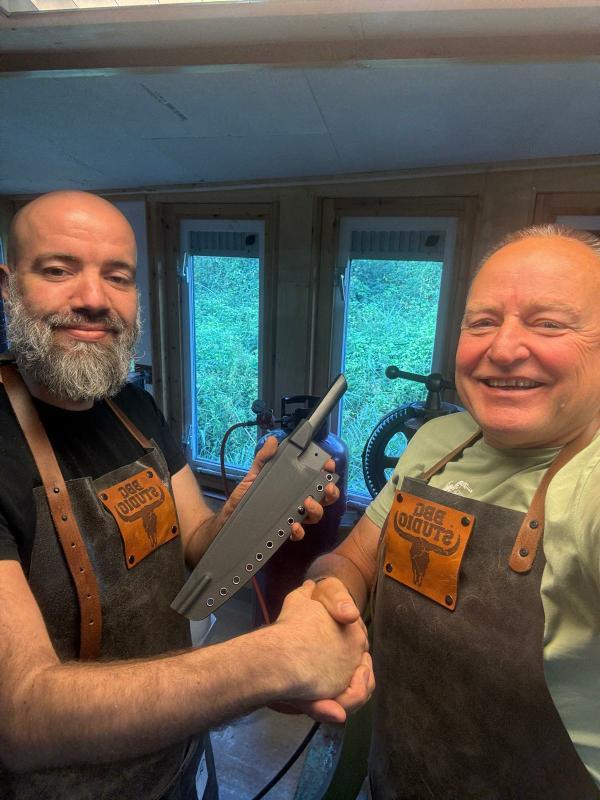
(photo – left to right Wilko Verboom, Harm-Jan BBQ Street)
In this week’s interview I am excited to share with you a knife maker who shares the sensibilities that inspired SteelForFood. Food is a necessity, but when you infuse food with love and artistry, you achieve something memorable. It is exactly the same when it comes to handmade kitchen knives.
To start off, please tell us a little about yourself.
Hello everyone, I am Wilko Verboom, I am 37 years old and live in Woerden, The Netherlands. I am engaged to a wonderful woman, Daniëlle Stokhof, who supports me in any way she can. We have a wonderful rescue dog named Kiran. I have an engineering degree in Industrial Product Design (IPO) and have a lot of experience
as a mechanical engineer designing machines for the food industry. In my spare time I often would work in my personal workshop, building and fabricating. It was frustrating to design the most amazing engineering wonders, but not being
able to connect a single bolt from that machine. So, I would work on the weekends in my workshop to building my own projects from scratch. I always have been an autodidactic (self-taught) fabricator so to say. Luckily that comes in handy with designing and making high end kitchen tools!
What sparked your interest in knives?
From a young age I have been interested with working with steel and because cooking was my hobby, creating kitchen knives was the most logical choice. In my kitchen I wanted something nice and high quality. After years of practice, experimenting, and learning I can honestly say that I am at a point where I can make
really good knives that are also pleasant to the eye. And according to my customers they are art pieces that are great to work with and will be heirlooms.
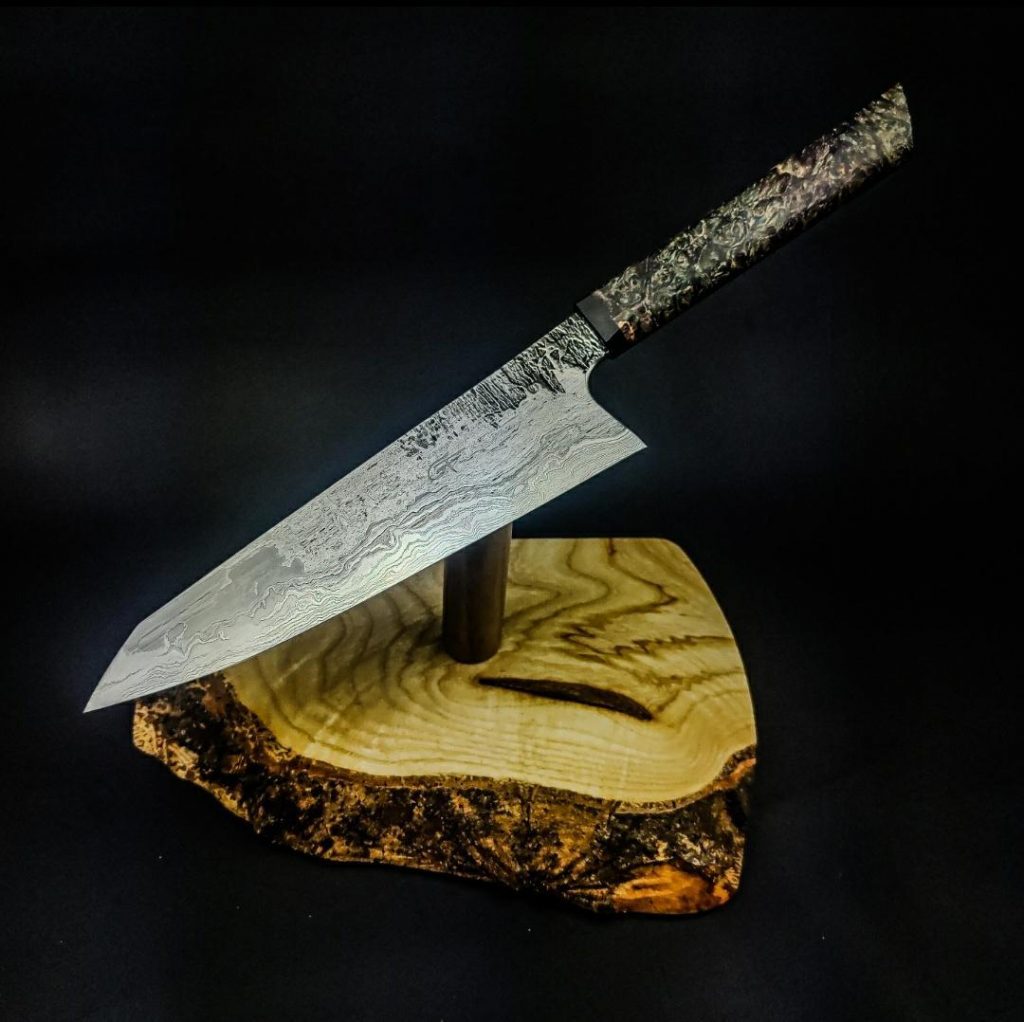
What inspired you to do this and how did you learn?
I remember that in the first year of secondary school we had a course called ‘technique’. I always had straight A’s for that course and the teacher trusted me with the machines. So, I was the only one who was allowed to use the bench grinder. I sharpened all the chisels in class. I saved up some money and bought my own bench grinder and decided to make a (straight) katana with mild steel. Also found out that I could get it sharper with sandpaper, so that’s basically where my hand sanding journey started.
My real spark came when I saw a documentary on Discovery about Japanese bladesmiths, I was hooked. I took a huge metal pipe and started to build my own coal forge. Got a stick welder from my uncle and started welding. I had no idea what I was
doing and did not know that you should not look at the flame when you first strike your welding rod to start it off. My eyes burned for a week. But I got on with it and used my mother’s hair dryer to blow hot air onto the coals and to get the steel red hot.
Melted the hairdryer… My mom was not amused…
I had a thick metal plate I used as an anvil and while I was pounding the metal I imagined being a blade smith that could
make huge swords. Of course I had no idea what I was doing. In those days YouTube educational learning was not really a thing. So, I had to gather a lot of information from hearsay, professors at my school, etc. Later on, in the beginning of Instagram, I had a lot of contact with many different makers. The bladesmith
community is a great community. Especially with the fulltime makers, we all know the struggles.
Gathering more and more machines and tools, I spend a lot of time refining my techniques. In my recent years I learned a lot from my contacts with Michelin starred chefs.
I have done a lot of trial and testing together with them. With making a really good kitchen blade, there is a lot of ‘feel’ required for the geometry. It all comes down to tiny refinements to go from a good blade to a great blade.
When did you start making knives?
I started making knife shape objects when I was the age of 13-14. So that’s about 19-20 years ago. But I really started making knives professionally about 7 years ago.
What did you make your first knife with?
Files, sandpaper and a bit later on with an old bench grinder from my grandfather.
Do you have a favorite knife you made, tell me about it?
My favorite knife is always the one that I am working on in that moment of time. It’s always gives me a lot of joy and satisfaction when a mental image comes to life through the power of my own hands and tools.
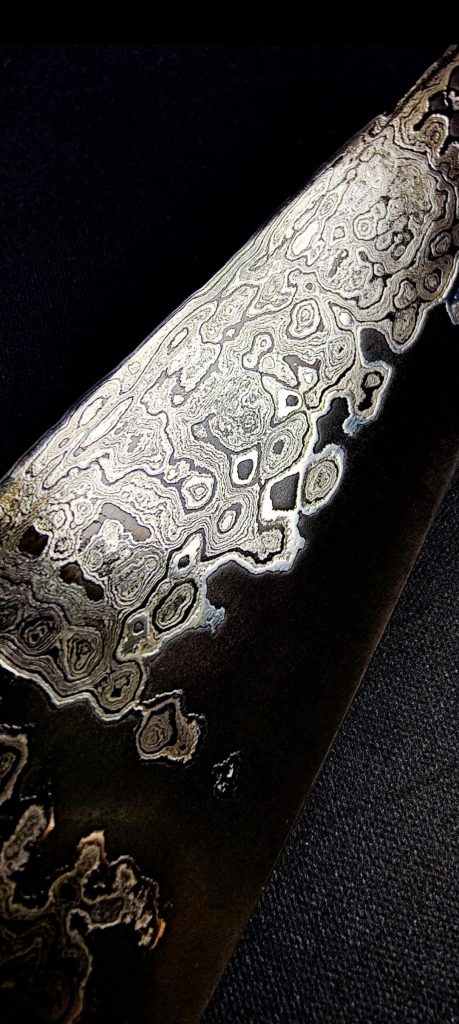
What is the most important aspect of a well-made knife?
The most important aspect to me is performance. If a high-end kitchen blade does not perform, why would you want to own it? Of course there are many more aspects. But I want my blades to evoke the feeling of just wanting to pick it up and start using
it. I always love it when a new customer comes over and tries out one of my knives. Their jaw dropping after the initial cut brings me joy. Fit and finish, design, balance, quality of the materials are also very important. But a good geometry, for the task it is intended to do, is the most important aspect for me. Without that, it will not leave my shop with my name on it.
What keeps you going?
Businesswise it’s my customers. They are all so kind and really share my passion for kitchen blades. But even if I did not have a fulltime business as a bladesmith, I would still be making knives. You never stop learning; there are so many different aspects that you can go in depth into. Take metallurgy for example, it is a whole different study. Then you have all the different types of
grinds you can put on a blade, sharpening processes (stone, belt, stropping), polishing (stones, diamond pastes, sand
paper, edm stones), forging with all the techniques to it.
Then there is also the artistic side of creating blades. Pattern welding (damascus), etching techniques, and so on. I could go on for a verry long time, but these are just some examples of what I mean.
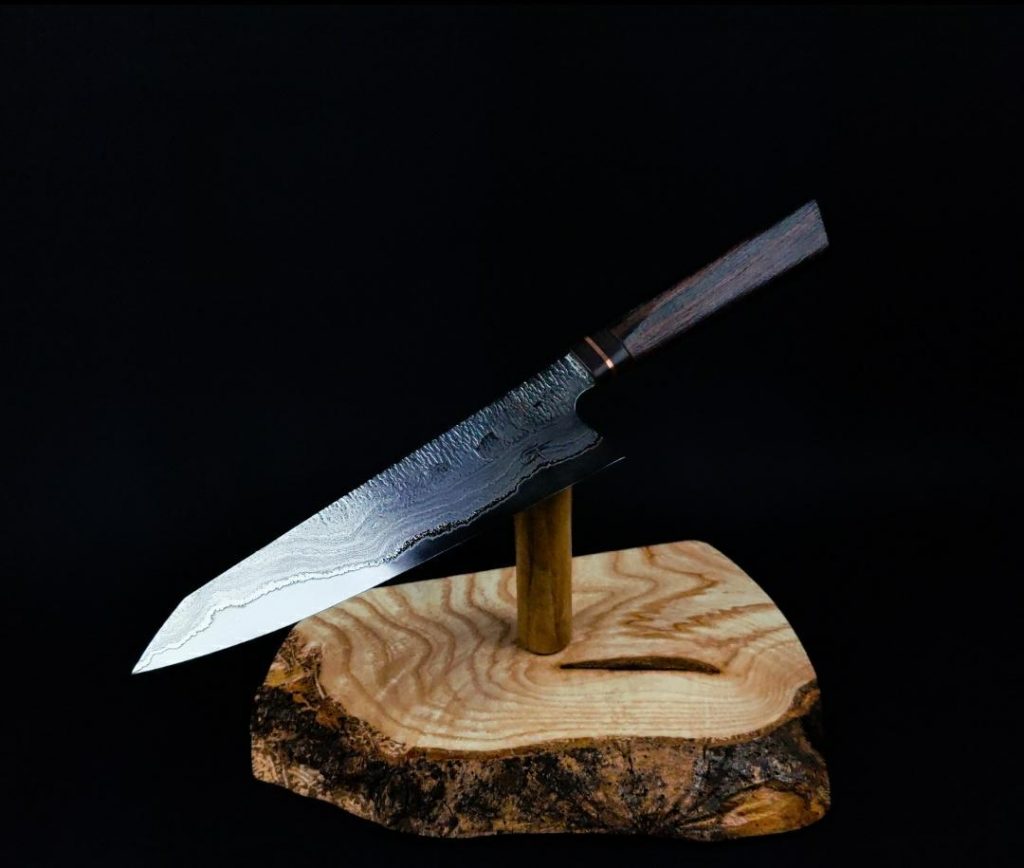
Biggest struggle?
Time management is always a struggle. It is difficult to take time off once in a while. Even when I am not making knives, I am still making them in my head. Trying to figure out new techniques, designing new tools or machines, etc.
What kinds of knives do you make?
My main focus is high end kitchen knives. But I also have made hunting knives, leather knives, and collectors’ items like bowies and tantos. But the biggest challenge is making good performing kitchen knives, so I tend to stick with that.
How did your background affect your approach to knives?
I think my background as an Industrial Product designer and engineer has helped me in my approach in the building aspect. I am used to pushing myself to the max and I always want to improve my work. Improvements can be made on the knives itself for example, but also in the way I approach the creating of the blades. Could be a different step in the process as well. Due to my education and experience in the field, I know a lot about different production methods. This also works against me sometimes, because the hunger for new tools and machines is non-stop…
Who helped you early on?
Well, my fiancé actually was the one who said I should take the leap of faith in starting my own business. She has always believed in me, even when I did not believe in myself for a moment to become a fulltime bladesmith. With the actual knife making, I
am grateful for many makers who I have had contact with. Waltteri Ryjenko really pushed me to bring my A game. But also, recently there are many makers who I have contact with. For example, I am going to visit Alfredo Faccipieri in Italy this summer. I hope we will be able to learn from each other and have a lot of fun
together.
Who are your influences?
Besides mother nature, it’s hard to say. I feel like every knife out there is derived from some type of blade from the past. Even when you don’t remember it anymore, there is a lot of content out there that could spark an idea. I have a lot of
respect for many makers.
What other knife makers out there impress you these days? Do you take inspiration from anyone else in the field?
I do have a lot of respect for many makers. Like Joshua Prince, he makes really unique pieces. Or Lee Lerman and Nati Amor, two exclusive folding knife makers, who do really incredible and precise work. I, for example have held a bolt made by Lee, that was so freaking tiny that it was hard to see the threading. And in that bolt, there was a mother of pearl inlay with three mini titanium tubes to tighten it. Makers like this inspire me to push myself to the max I can do with the time (and budget) that I get from my customers.
Any specific breakthroughs or revelations in your knife making journey?
Good question, and yes, so many, I could write a book… Like I said before, there are so many different aspects to knifemaking. It’s a journey of a lifetime, that I actually dedicated my life to. To someone who is new to the whole knife scene it might be
minor at the beginning, but the deeper you get the greater the total picture of all the aspects becomes.
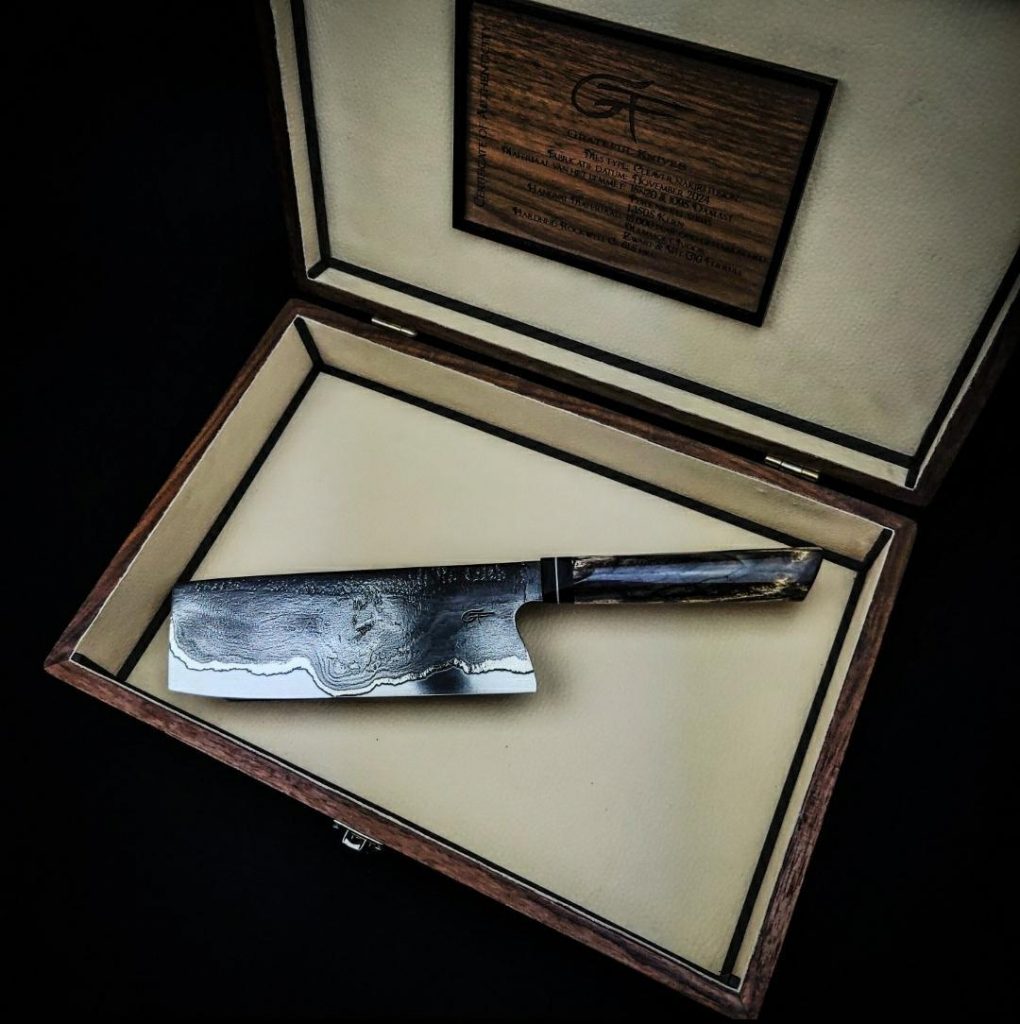
What is the perfect knife?
I could say a standard marketing answer like a well-balanced high performing piece of art. That is of course what custom knives are all about. But to me a perfect knife does not exist. There will always be something to improve if you look close enough.
That’s also the beauty of knifemaking, it’s a pursuit of perfection that will never be reached. Because when you reach a certain point of perfection, your eyes and knowledge will be trained further, so there is a new bar that can be chased. So the
‘set point’ of perfection is actually moving beyond your skills as you grow as a craftsman.
How do you approach knife testing?
I have reached a point right now where I can cut a potato, and with the first initial cut, I will know what I have done is spot on or that I have more work to do. Before I got to this point, I did destruction tests, hardness testing, kitchen testing, letting professional Michelin chefs try out my blades to get the best feedback from my users. But at the moment I am confident about the quality of my blades. I still do hardness testing etc. Just to check if there are differences in between the batches of steel.
How has the knife world changed since you started?
Social media has changed a lot. When I started out, YouTube wasn’t a thing. I had to do a lot of experimentation when I was younger. These days information is not difficult to come by anymore. Although there are still many myths being slung into YouTube, Reddit, and places like that, but there are many good resources like knife steel nerds, etc.
What’s up next for you? Any exciting new projects to tell us about?
Oh yes there is! I am launching a web-shop soon, with a special section for custom orders. It will be like nothing you have ever seen before!
I am also launching a semi production knife. (forged and produced by me) This blade will be primary focused on performance. This is to give my fans and followers who don’t have the deep pockets to pay for a high-end custom blade of mine, the possibility to own one of my blades for a lot less. They will have belt finishes and a more standardized handle to keep the manufacturing costs low. But they will have almost the same cutting capability as my custom work. So, the customer can experience what it is like to own and use one of my handmade knives. For the those who want to be a part of this group, I would recommend to sign-up for my newsletter, then they will be the first to find out more about the launch! I only have two hands, and there are only so many blades I am able to make.
To see more of his work visit his website https://gratefulknives.com/ or check out his Instagram https://www.instagram.com/gratefulknives/
4 responses to “Grateful Knives”
-
Love this guy, he’s the best.
Not only in knife making, he will treat you with the same respect and care as you can find back in his precision art. If you have hold one of his knives you know what I mean.-
I look forward to experiencing his work myself.
-
-
Wilko is a great guy! How he is in this interview is exactly how I know him in person, honnest and knows what he is talking about.
I own one of his knives and I love working with it. It’s my daily go to knives in the kitchen.-
He is a great guy. Glad to hear you have enjoyed using his work.
-
Leave a Reply to Bas Cancel reply